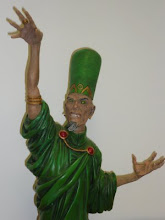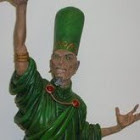Mad science, hyperbolic writing and ravishing art just about balance the rampant sexism in a beautifully presented collection of comics. The Doom Patrol , Rita Farr (Elati-Girl), Cliff Steele (Robotman), Larry Trainor (Negative Man), Niles Caulder (The Chief) along with two semi-attached members , Steve Dayton (Mento) and Craig Logan (Beast Boy) are the World's Strangest Heroes.
The writing by Arnold Drake is full of wonderful ideas, operatic villains and and full tilt storytelling. He crams each short episode with ideas and explosive situations, two of my favorites are the killer rabbits and the way a dumper truck is used a giant sieve. The cast are bursting with loud, expressive life, they insult each other with elaborate detail and maintain a level of simmering tension and rage that is entirely consistent with the fact that they have all been so severely dislocated from their previous lives. They are free only in action as they bring their abilities to bear on a problem, peace does not suit them. The dialogue is a very effective mix of terrible puns, insults and decelerations, it is as entirely as unnatural as the Doom Patrol themselves and it suits them perfectly. The narration is so hyperbolic that it should collapse on itself, instead the breathless urgency of it all captures the speed and sheer absurdity of the action. The exaggerated seriousness of the writing underscores the way the absurdity is taken utterly seriously, the cast are never mocked by the writing, they are given force and character by the excess.
The problem with the stories is serious also, the entirely natural and deeply ingrained sexism that very nearly renders the stories unreadable. Rita Farr is treated with a such an appalling paternalistic protectiveness that it pushes the reader right out of the story. What is obvious is that Arnold Drake greatly liked Rita Farr and gave her as much room to shine as it was possible to do while being constrained at every turn by the male cast responses to her.
What makes the difference and rescues the collection is the astounding art by Bruno Premiari that makes the nearly impossible task he is presented with look easy. He has to take a set of misfit heroes and utterly absurd situations and make them credible by humanising the cast so that the action is funny, serious and wholly comic book mad science all at the same time. Robotman may be the most expressive robot ever , his metal face is as readable as any human face yet essentially robotic, he captures the human wired up inside the metal frame. Beast Boy, whose transformation always leave him with his head of human, green hair, is full of energy and the sheer joy of the possibilities that are open to him. When he is the lonely teenager looking for acceptance within the Doom Patrol, he is also defensively angry and arrogant, his body language speaks as loudly as his voice.
The malice free sexism is an enormous drag on the collection, that the astonishing invention and the great team dynamic that propel the book graced with such joyous art just about rescue it is the greatest compliment I could pay it.
The writing by Arnold Drake is full of wonderful ideas, operatic villains and and full tilt storytelling. He crams each short episode with ideas and explosive situations, two of my favorites are the killer rabbits and the way a dumper truck is used a giant sieve. The cast are bursting with loud, expressive life, they insult each other with elaborate detail and maintain a level of simmering tension and rage that is entirely consistent with the fact that they have all been so severely dislocated from their previous lives. They are free only in action as they bring their abilities to bear on a problem, peace does not suit them. The dialogue is a very effective mix of terrible puns, insults and decelerations, it is as entirely as unnatural as the Doom Patrol themselves and it suits them perfectly. The narration is so hyperbolic that it should collapse on itself, instead the breathless urgency of it all captures the speed and sheer absurdity of the action. The exaggerated seriousness of the writing underscores the way the absurdity is taken utterly seriously, the cast are never mocked by the writing, they are given force and character by the excess.
The problem with the stories is serious also, the entirely natural and deeply ingrained sexism that very nearly renders the stories unreadable. Rita Farr is treated with a such an appalling paternalistic protectiveness that it pushes the reader right out of the story. What is obvious is that Arnold Drake greatly liked Rita Farr and gave her as much room to shine as it was possible to do while being constrained at every turn by the male cast responses to her.
What makes the difference and rescues the collection is the astounding art by Bruno Premiari that makes the nearly impossible task he is presented with look easy. He has to take a set of misfit heroes and utterly absurd situations and make them credible by humanising the cast so that the action is funny, serious and wholly comic book mad science all at the same time. Robotman may be the most expressive robot ever , his metal face is as readable as any human face yet essentially robotic, he captures the human wired up inside the metal frame. Beast Boy, whose transformation always leave him with his head of human, green hair, is full of energy and the sheer joy of the possibilities that are open to him. When he is the lonely teenager looking for acceptance within the Doom Patrol, he is also defensively angry and arrogant, his body language speaks as loudly as his voice.
The malice free sexism is an enormous drag on the collection, that the astonishing invention and the great team dynamic that propel the book graced with such joyous art just about rescue it is the greatest compliment I could pay it.



